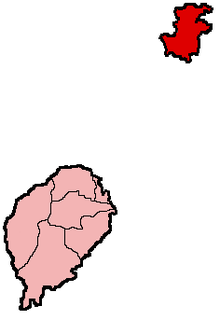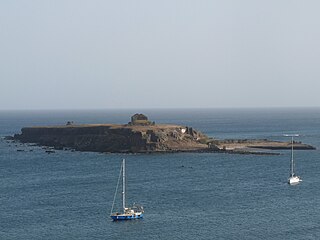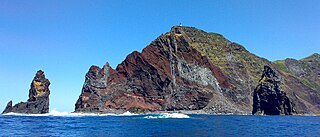
Corvo Island, literally the Island of the Crow, is the smallest and the northernmost island of the Azores archipelago and the northernmost in Macaronesia. It has a population of approximately 384 inhabitants making it the smallest single municipality in the Azores and in Portugal. The island lies on the North American Plate.

Germano Almeida is a Cape Verdean author and lawyer.

The Capelinhos is a monogenetic volcano located on the western coast of Faial Island in the Azores. It is part of the larger volcanic complex of Capelo, which includes 20 scoria cones and lava fields that are aligned west-northwest to east-southeast from the Caldeira Volcano caldera. Although the name "Capelinhos" is associated with the volcano, it technically refers to the western cape of the parish of Capelo. It can be considered the westernmost point of Europe; there are more westerly islands in the Azores archipelago but they lie on the North American Plate.

The Barlavento Islands is the northern group of the Cape Verde archipelago. It presents as two sub-groups:

The Autonomous Region of Príncipe is an autonomous administrative division of the Republic of São Tomé and Príncipe. Established on 29 April 1995, it covers the island of Príncipe and a number of small uninhabited islands around it, with an area of 142 km2 (55 sq mi) in total. As defined by the constitution of São Tomé and Príncipe, the Autonomous Region of Príncipe has a Regional Assembly and a Regional Government. Its population was 7,324 at the 2012 census; the latest official estimate was 8,420. It consists of a single district: Pagué. Its seat is the town Santo António.

The Cabras Islets or Cabras Islet is an uninhabited dual islet located along the southern coast of the island of Terceira in the Portuguese archipelago of the Azores. The group, with a total area of 29 hectares and perimeter of 3,239 metres (10,627 ft), is the largest islet in the Azores. Locals normally refer to it as a single islet, but it comprises two landforms: the Ilhéu Pequeno and the Ilhéu Grande.
The Fort of the Caninas, is a medieval fort situated in the Portugueses civil parish of Porto Judeu, municipality of Angra do Heroísmo, in the archipelago Azores.
Fort of the Cavalas is a fort situated in the civil parish of São Sebastião in the municipality of Angra do Heroísmo, in the Portuguese archipelago of the Azores.

Monchique Islet is a small uninhabited islet off the coast of the island of Flores, west of the village of Fajã Grande, in the western part of the Portuguese archipelago of the Azores. It is the westernmost point of Portugal and, if considered part of Europe, is Europe's westernmost point as well.

Santa Maria Natural Park is a protected area on Santa Maria Island in the Azores. The park was created by the Secretaria Regional do Ambiente e do Mar, of the Autonomous Regional Government of the Azores to better manage the protected areas of Santa Maria Island. Several natural landscapes were preserved and their use conditioned in order to foster conservation and support endemic flora and fauna species, as well as provide communal forms of recreation and nature interpretation.

Ilhéu de Santa Maria is a small uninhabited islet of the Sotavento archipelago in Cape Verde located off the shore of the island Santiago. Like all Cape Verdean islands, the islet is of volcanic origin. The islet has an area of roughly 0.05 square kilometres and is 420 metres long and 130 metres wide. It is situated at the entrance of Praia Harbour, in front of Praia da Gamboa, near the city centre of Praia.
The Fort of Greta is a fort along the promontory of Santa Catarina, on the western edge of the Bay of Mós, in the civil parish of Vila de São Sebastião, in the municipality of Angra do Heroísmo, on the Portuguese archipelago of the Azores.

Baixo Islet, also known locally as Ilhéu do Carapacho and historically as Ilhéu dos Homiziados, is a small uninhabited islet group located off the southeast coast of the island of Graciosa in the Portuguese archipelago of the Azores. Along with Praia Islet to its north, Baixo Islet is one of two main breeding places of Monteiro's storm petrel, an endemic marine bird of the Azores.

Praia Islet is a highly vegetated uninhabited islet located approximately 1.5 kilometres away from the town of Praia off the eastern coast of the island of Graciosa in the Portuguese archipelago of the Azores. Along with Baixo Islet to its south, Praia Islet is one of two main breeding places of Monteiro's storm petrel, an endemic marine bird of the Azores.

The Rosais Islets are two uninhabited rocky islets located just off the extreme northwestern coast of the island of São Jorge in the Portuguese archipelago of the Azores.

Vila Franca Islet is a vegetated uninhabited islet located off the south-central coast of the island of São Miguel in the Portuguese archipelago of the Azores. The entire islet and surrounding waters constitute a protected nature reserve, while remaining a popular destination for swimming and cliff diving.
This page is based on this
Wikipedia article Text is available under the
CC BY-SA 4.0 license; additional terms may apply.
Images, videos and audio are available under their respective licenses.












